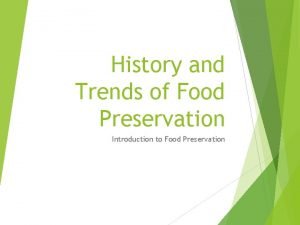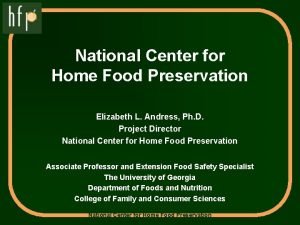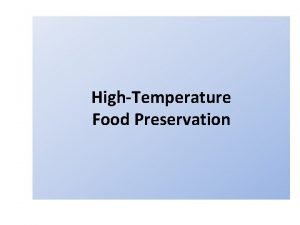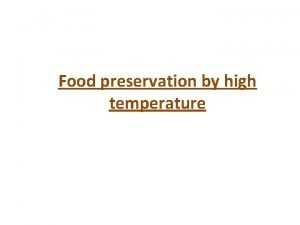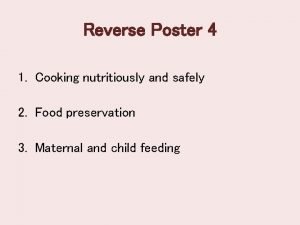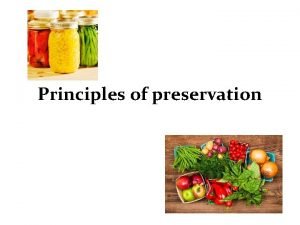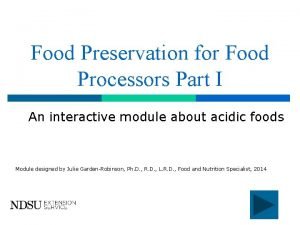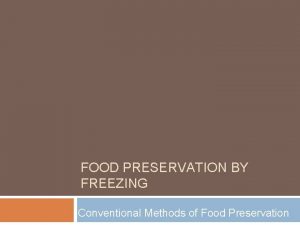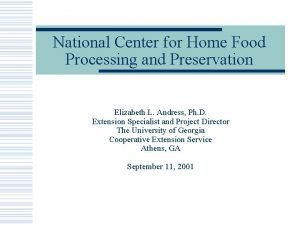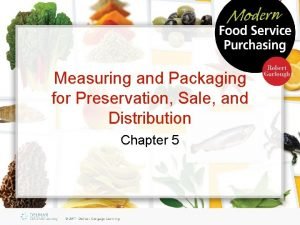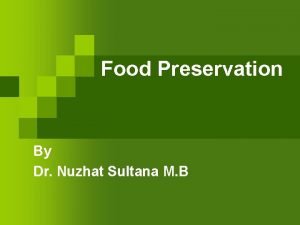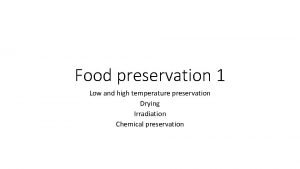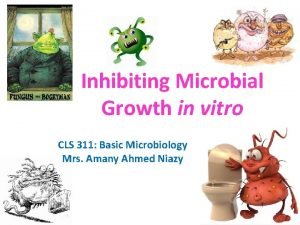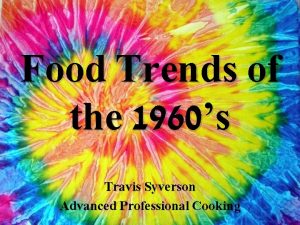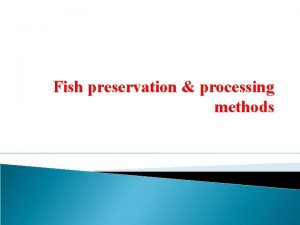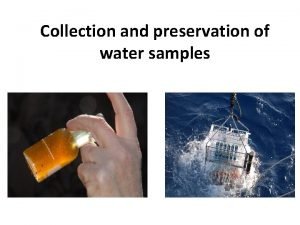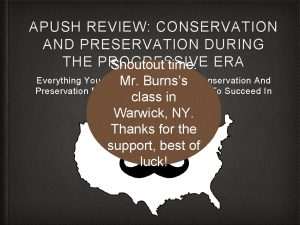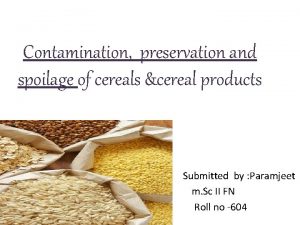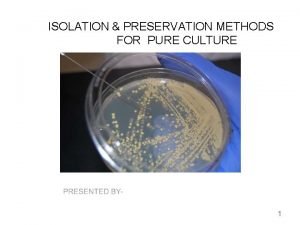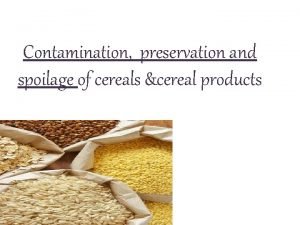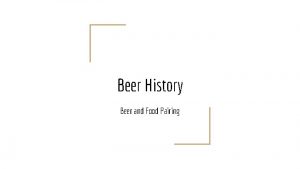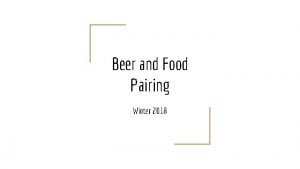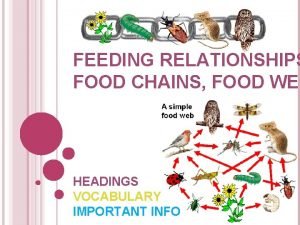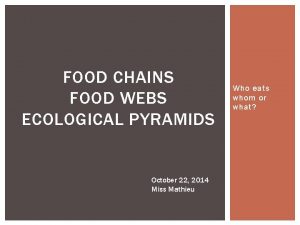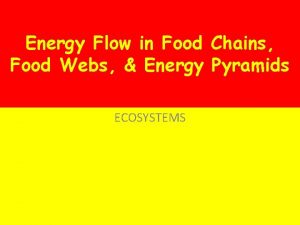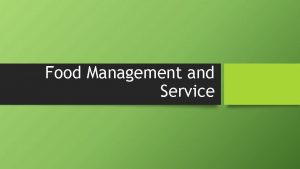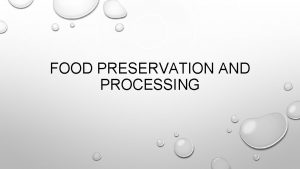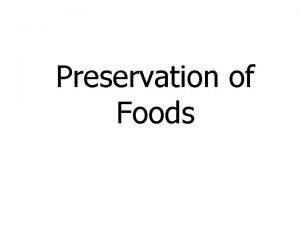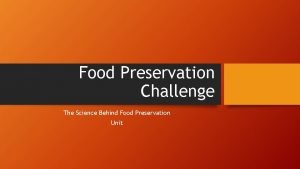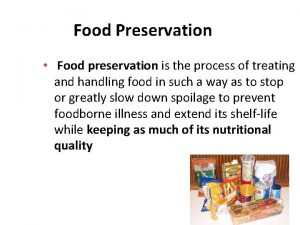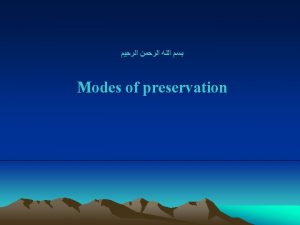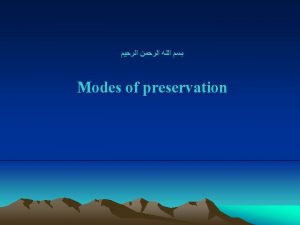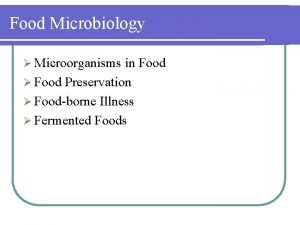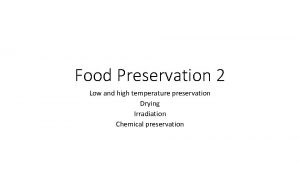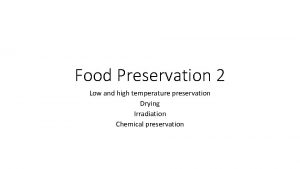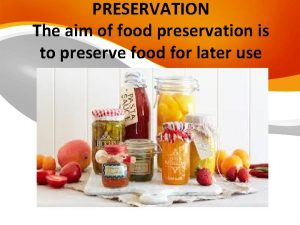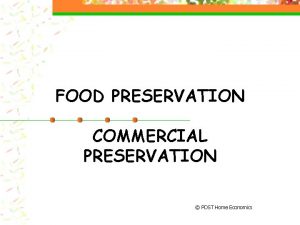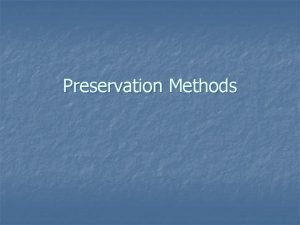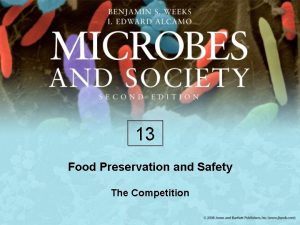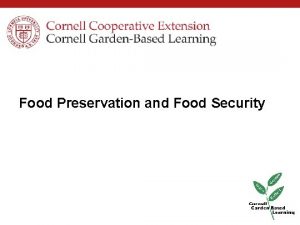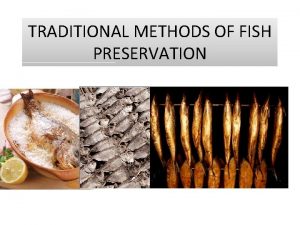History and Trends of Food Preservation Introduction to







































- Slides: 39

History and Trends of Food Preservation Introduction to Food Preservation

Objectives Student’s will be able to: Define food preservation Summarize five common historical methods of food preservation Describe current technologies for food preservation Discuss current trends in food preservation Identify why we need to preserve food Discuss why some people preserve their own food

Activity Why does fresh bread go bad? Why do fresh donuts go bad? Why do packaged bread or donuts not go bad?

Food Preservation Methods of treating foods to delay the deterioration of the food. Changing raw products into more stable forms that can be stored for longer periods of time. Allows any food to be available any time of the year in any area of the world.

Historical Methods of Food Preservation Primitive and tedious methods Drying Salting Sugaring Pickling Cold storage

Drying Used to preserve fruit, vegetables, meats, and fish. Mainly used in the south – warmer climate. Causes the loss of many natural vitamins.

Salting Used extensively for pork, beef, and fish. Costly due to high price of salt. Done mainly in cool weather followed by smoking.

Sugaring Used to preserve fruits for the winter. Jams and jellies. Expensive because sugar was scarce commodity in early America.

Pickling Fermenting Used to preserve vegetables. Use mild salt and vinegar brine. Increases the salt content and reduces the vitamin content of the food. Oldest form of food preservation.

Cold Storage Used extensively in the northern U. S. Root cellars were used to store vegetables at 30 -40 degrees F. Root cellars were replaced by ice boxes in the mid 1800’s.

Factors Affecting Diet – Colonial Times Where you lived. Long winters in the north led to different diets in in the south. Nutritious diets were unknown to early Americans.

Reasons for Dietary deficiencies Fruits and vegetables were available only during short seasons. Inadequate and time consuming food preservation methods. Lack of facilities for rapid transport of food from long distances. Contamination of food supplies.

Diet Today We can eat fresh vegetables from anywhere in the world today!! Bananas Strawberries Pineapples

Factors that Changed Food Science Technology Canning – revolutionized food preservation and made it more available. Commercial freezing and refrigeration – allowed preservation of meats. Refrigerated rail cars and trucks – increased the availability of fresh fruits, vegetables and meats. Food preservatives.

Food Preservatives Retard or reduce the growth of undesirable microorganisms, mold and bacteria. Do not affect from food texture or taste. Safe for human consumption. Extend shelf-life of food. Shelf-life – length time before a food product begins to spoil.

Today’s Food Industry Improvements have led to the replacement of the housewife as the major preparer or food preserver. Today it is done by machine and shipped to stores all over the world.

Food preservation is needed, especially today with the large world population.

Current Technologies in Food Preservation

Activity List the foods you like to eat all year. Use this list to eliminate foods that were not available 10, 20, 30 years ago. Eliminate foods not available in your area.

Types of Food Processing Heating Blanching Vacuum Packaging Drying Refrigeration Freezing Chemicals

Heating Started in 1800’s. Known as canning – putting hot food in jars to seal. Food is cooked to extremely high temperatures, put into jars and lids are placed on them. Lids are sealed from the heat and this prevents bacteria from growing and spoiling the food.

Blanching Used for vegetables. Heat the food with steam or hot water to 180 -190 degrees F. This prevents bacteria from growing. Hot food is cooled in ice water.

Benefits of Blanching Shrinks the product, better for filling the container. Destroys enzymes in the food. Fixes the natural color of vegetables – holds their color.

Vacuum Packaging Removes oxygen. Oxygen reacts with food causing undesirable changes in color and flavor.

Drying Oldest form Methods of food preservation. Sun drying Hot air drying – mechanical dehydrator Fluidized-bed drying Drum drying – milk, fruit, veg. juices, cereals Spray drying – milk, eggs, coffee, syrups Freeze drying Puff drying – Fruit or vegetable juices

Refrigeration Early time, ice and snow was used. Now the most popular method of food preservation. 85% of all foods are refrigerated. Greatly changed our eating habits.

Freezing Used by Eskimos and Indians Frozen foods are a staple in every American home.

Chemicals Salt was first chemical used to preserve foods. Na. Cl – salt; makes water unavailable to microorganisms. Changes the p. H of the food not allowing microorganisms to live.

Chemical Additives sodium nitrate fatty acids sulfur dioxide sorbic acid diethyl pyrocarbonate oxidizing agents benzoates antibiotics antioxidants

Salt Oldest known food additive. Used in meats, cheeses, bread. Americans consume 10 -12 grams per day; 10 pounds per year. Prevents spoilage.

Salt 3 basic properties Flavor Protein extraction Microbial control

Trends in Food Science

Scope of Food Industry Largest industry in U. S. Employs 14, 000 people. Includes agricultural production, fishing, processing, transportation, wholesaling, retailing, warehousing, containerizing.

Scope of Food Industry Related to all other industries. Most important industry to man. Americans spend $100 billion annually for food; 1/5 of all spending.

World Trends Affecting Food Science Increase in world’s population is faster than increase in food supplies. Worsening worldwide food situation – large exports of grain; decrease in U. S. food reserves.

World Trends Affecting Food Science Scientists must obtain high productivity from small amounts of land. Large food demand, small food supply.

What is the Supermarket A business that allows for greater varieties of products and product forms, prepared foods, automatic vending, fastorder foods.

Development of the Supermarket Expanded food industry Large food stores and transportation has led to large shopping centers Offers lower prices, bigger selections Wal-mart, Target, SAMS

Activity: Reasons for Food Preservation at home Discuss why some people preserve their own food. To save money To avoid chemical preservatives To avoid chemicals(fertilizers, hormones, etc. ) added to food while growing
 Food preservation history
Food preservation history National food preservation
National food preservation High temperature in food preservation
High temperature in food preservation Control of temperature in food preservation
Control of temperature in food preservation Food preservation poster
Food preservation poster Heat preservation
Heat preservation Microwave food preservation
Microwave food preservation Food preservation definition
Food preservation definition Freezing
Freezing Burying meat in the ground
Burying meat in the ground National center for home preservation
National center for home preservation Advantages of vegetables
Advantages of vegetables Nuzhat sultana
Nuzhat sultana Food preservation by high temperature
Food preservation by high temperature Physical method of food preservation
Physical method of food preservation Application of hurdle technology
Application of hurdle technology Chapter 1 history and trends of health care
Chapter 1 history and trends of health care Chapter one history and trends of health care
Chapter one history and trends of health care Unit 2 food food food
Unit 2 food food food Eltonian pyramid
Eltonian pyramid 60s food trends
60s food trends Fish preservation and processing
Fish preservation and processing Dussart flask water sampler
Dussart flask water sampler Preservationist apush
Preservationist apush Chalky bread
Chalky bread Isolation pure culture
Isolation pure culture Rope spoilage bread
Rope spoilage bread Careful protection and preservation of environment
Careful protection and preservation of environment Root beer food pairing
Root beer food pairing Epidimorchitis
Epidimorchitis Current and future trends of media and information.
Current and future trends of media and information. Food web diagrams
Food web diagrams Producer in food web
Producer in food web Food chain relationships
Food chain relationships A consumer that primarily eats one specific organism
A consumer that primarily eats one specific organism What is food web
What is food web Food chains, food webs and ecological pyramids
Food chains, food webs and ecological pyramids Food webs and energy pyramids
Food webs and energy pyramids Food chain
Food chain Dessert food chain
Dessert food chain
